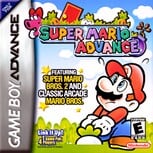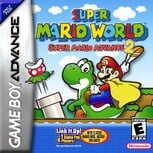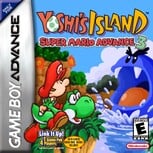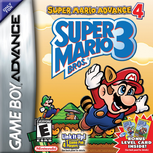Super Mario Advance (series): Difference between revisions
(→Changes from the original games: Removed "as" in "referred to *as* by her current name".) |
mNo edit summary |
||
| (75 intermediate revisions by 34 users not shown) | |||
| Line 1: | Line 1: | ||
{{italic title | {{italic title}} | ||
{{series | {{series infobox | ||
|image=[[File:SMAlogo.png|270px]] | |image=[[File:SMAlogo.png|270px]] | ||
|first=''[[Super Mario Advance]]'' ([[List of games by date#2001|2001]]) | |first=''[[Super Mario Advance]]'' ([[List of games by date#2001|2001]]) | ||
|latest=''[[Super Mario Advance 4: Super Mario Bros. 3]]'' ([[List of games by date#2003|2003]]) | |latest=''[[Super Mario Advance 4: Super Mario Bros. 3]]'' ([[List of games by date#2003|2003]]) | ||
|number=4 | |number=4 | ||
|parent=[[Mario (series)|''Mario'']] | |parent=[[Super Mario (series)|''Super Mario'']] | ||
|franchise=[[Super Mario (franchise)|''Super Mario'']], [[Yoshi (franchise)|''Yoshi'']] | |||
}} | }} | ||
The '''''Super Mario Advance''''' series is a series of video game | The '''''Super Mario Advance''''' series is a [[Super Mario (series)|''Super Mario'']] subseries which consists of video game [[reissue]]s released only on the [[Game Boy Advance]]. It is a successor to ''[[Super Mario Bros. Deluxe]]'' on the [[Game Boy Color]],<ref >[http://www.nintendo.co.jp/nom/0103/031/index.html Interview on Nintendo's Japanese website], ''Nintendo''. Retrieved March 30 2015 (partial translation available [http://www.marioboards.com/index.php?topic=28694.msg1695195#msg1695195 here])</ref><ref>Marionova64 (July 30, 2020). [https://twitter.com/Marionova64/status/1288818364132057093 Super Mario Advance Unused Title Screen Voicelines]. ''Twitter''. Retrieved August 6, 2020.</ref> itself an indirect successor to ''[[Donkey Kong (Game Boy)|Donkey Kong]]'' on the [[Game Boy]]. Each game contains a classic ''[[Super Mario (franchise)|Super Mario]]'' or ''[[Yoshi (franchise)|Yoshi]]'' sidescroller, with improved graphics, sound, and additional features. Also, each game contains an [[Mario Bros. (Game Boy Advance)|updated version]] of the 1983 arcade game ''[[Mario Bros. (game)|Mario Bros.]]'' with multiplayer access. The series finished in 2003 with four games, although ''[[New Super Mario Bros.]]'', the first original 2D ''Mario'' platformer since 1992's ''[[Super Mario Land 2: 6 Golden Coins]]'', was developed as a response to requests for a fifth ''Super Mario Advance'' entry.<ref>[http://web.archive.org/web/20101207010424/http://us.wii.com/iwata_asks/mario25th/vol3_page4.jsp Iwata Asks: Super Mario Bros. 25th Anniversary (archived)]</ref> | ||
==Games== | ==Games== | ||
{| align=center width=100% | {| align=center width=100% class="wikitable" | ||
|- style="background-color: | |- | ||
!width= | !width=15% style="background-color: #d9d9d9;font-size:125%;text-align:left" colspan="2"|Title | ||
!width= | |- | ||
!width=15% style="background-color: #e0e0e0;"|Cover and release date | |||
!width=85% style="background-color: #e0e0e0;"|Synopsis | |||
|- | |||
!colspan="2" style="font-size:125%;text-align:left"|''[[Super Mario Advance]]'' | |||
|- | |- | ||
|[[File:SMA.jpg|153px]]<span style="font-size:8pt"><br>{{release|Japan|March 21, 2001<ref name="FAQ">[http://www.gamefaqs.com/gba/472572-super-mario-world-super-mario-advance-2/faqs/28593 GameFAQs] Retrieved November 14, 2010</ref>}}</span> | |||
|''Super Mario Advance'' features the classic game ''[[Super Mario Bros. 2]]'', based heavily on the ''[[Super Mario All-Stars]]'' [[Reissue#Ports|port]] of the game, although in the game it is referred to as ''Super Mario 2''. Nintendo's decision to choose this title as a Game Boy Advance launch game was seen by some as misguided; GameSpot in particular thought that ''[[Super Mario Bros. 3]]'' or ''[[Super Mario World]]'' would have been far better choices for a launch title considering their popularity (both of these titles would ultimately be remade as part of the ''SMA'' series). Nonetheless, IGN praised the choice, calling it "one of the most polished and creative platformers of the era", and it was a best-selling GBA launch game. | |||
[[File:SMA.jpg|153px]] | |||
- | Later, the game would become a part of the [[Player's Choice]] lineup for the Game Boy Advance as one of the system's first three Player's Choice games (along with ''Mario & Luigi: Superstar Saga'' and ''Yoshi's Island: Super Mario Advance 3''). It was later released for [[Wii U]] through [[Virtual Console]] initially in 2014, and added to [[Game Boy Advance - Nintendo Switch Online]] in 2023. | ||
{{ | |||
|'' | |||
|- style=font-size:8pt align=center| | |- style=font-size:8pt align=center| | ||
|- | |- | ||
!''Super Mario World: Super Mario Advance 2 | !colspan="2" style="font-size:125%;text-align:left"|''[[Super Mario World: Super Mario Advance 2]]'' | ||
|- | |||
[[File:Box NA - Super Mario World Super Mario Advance 2. | |[[File:Box Art NA - Super Mario World Super Mario Advance 2.jpg|153px]]<span style="font-size:8pt"><br>{{release|Japan|December 14, 2001<ref name="FAQ"/>}}</span> | ||
- | |As the name suggests, ''Super Mario World: Super Mario Advance 2'' features ''Super Mario World''. It is the second video game in the ''Super Mario Advance'' series. | ||
{{ | |||
|As the name suggests, '' | It was later released for Wii U through Virtual Console initially in 2014, and added to Game Boy Advance - Nintendo Switch Online in 2023. | ||
|- style=font-size:8pt align=center | |- style=font-size:8pt align=center | ||
|- | |- | ||
!''Yoshi's Island: Super Mario Advance 3 | !colspan="2" style="font-size:125%;text-align:left"|''[[Yoshi's Island: Super Mario Advance 3]]'' | ||
|- | |||
[[File:Super Mario Advance 3 Box Art.jpg|153px]] | |[[File:Super Mario Advance 3 Box Art.jpg|153px]]<span style="font-size:8pt"><br>{{release|Japan|September 20, 2002<ref name=FAQ/>}}</span> | ||
- | |''Yoshi's Island: Super Mario Advance 3'' is a port of ''[[Super Mario World 2: Yoshi's Island]]'' for the Game Boy Advance. It is very much like the original version, though it has six new levels and ''[[Yoshi's Story]]'' sound effects. | ||
{{ | |||
|'' | It was later released for [[Nintendo 3DS]] and Wii U through Virtual Console, though the former release is exclusive to the Nintendo 3DS Ambassador Program. It was also added to Game Boy Advance - Nintendo Switch Online in 2023. | ||
|- style=font-size:8pt align=center | |- style=font-size:8pt align=center | ||
|- | |- | ||
!''Super Mario Advance 4: Super Mario Bros. 3 | !colspan="2" style="font-size:125%;text-align:left"|''[[Super Mario Advance 4: Super Mario Bros. 3]]'' | ||
|- | |||
[[File:Super Mario Advance 4 Box.png|153px]] | |[[File:Super Mario Advance 4 Box.png|153px]]<span style="font-size:8pt"><br>{{release|Japan|July 11, 2003<ref name="FAQ"/>}}</span> | ||
- | |In 2003, the fourth and final entry in the ''Super Mario Advance'' series, ''Super Mario Advance 4: Super Mario Bros. 3'', was released for the Game Boy Advance. It is a heavily updated version of ''Super Mario Bros. 3'', as the name suggests. However, it boasts similar graphics and sound to the ''All-Stars'' version. It features a save system similar to the ''Super Mario All-Stars'' save system, except temporary saves may now be done anywhere. | ||
{{ | |||
|In 2003, the fourth and final entry in the ''Super Mario Advance'' series, '' | This game's largest added feature (except in the European version) is compatibility with the [[e-Reader]] and its [[Super Mario Advance 4: Super Mario Bros. 3 e-Reader cards|cards]]. These cards can be scanned into the game and function as new levels ([[World-e]]), instant power-ups, or demos. One power-up card features a power-up that was not found in any other ''Super Mario'' game until ''[[Super Mario 3D Land]]'': the [[Boomerang]]. The 2016 Virtual Console release would fully include these levels and make them available worldwide for the first time. The levels were again made available in the game's release on the Game Boy Advance - Nintendo Switch Online service during its 2023 launch. | ||
|} | |} | ||
== Changes from the original games == | ==Changes from the original games== | ||
*In ''Super Mario Advance'', ''Super Mario Advance 2: Super Mario World'' and ''Super Mario Advance 4: Super Mario Bros.3'', [[Princess Toadstool]] | *In ''Super Mario Advance'', ''Super Mario World: Super Mario Advance 2'' and ''Super Mario Advance 4: Super Mario Bros. 3'', there are added voice clips for each player character and most bosses. | ||
*In ''Super Mario | *In line with the current standard, ''Super Mario Advance'', ''Super Mario World: Super Mario Advance 2'' and ''Super Mario Advance 4: Super Mario Bros. 3'', now also refer to [[Princess Peach|Princess Toadstool]] as "Peach" (as introduced to the West in ''[[Yoshi's Safari]]'' and retained in ''[[Super Mario 64]]'' onward). | ||
*In ''Super Mario Advance'', | *In ''Super Mario World: Super Mario Advance 2'', Luigi is playable as the first player, and has his special attributes from ''Super Mario Bros. 2'', with a higher jump, and lower traction. | ||
*In ''Super Mario Advance 4: Super Mario Bros 3'', there are additional levels based on e-Reader cards. | *In ''Super Mario Advance 4: Super Mario Bros. 3'', some levels have been slightly altered to fit on the GBA screen. | ||
*In ''Super Mario Advance 4: Super Mario Bros. 3'', there are additional levels based on e-Reader cards. | |||
==Gallery== | ==Gallery== | ||
<gallery> | <gallery> | ||
Super Mario Advance logo.png|American logo of ''[[Super Mario Advance]]'' | |||
LogoChinese SMAdvance.png|Chinese logo of ''Super Mario Advance'' | |||
SMA Japanese Box Art.png|The Japanese game cover for ''Super Mario Advance'' | |||
Yoshis island logo.png|American logo of ''[[Yoshi's Island: Super Mario Advance 3]]'' | |||
LogoChinese YI-GBA.png|Chinese logo of ''Yoshi's Island: Super Mario Advance 3'' | |||
SuperMarioAdvance4JPBoxArt.jpg|Japanese box art of ''[[Super Mario Advance 4: Super Mario Bros. 3]]'' | |||
</gallery> | </gallery> | ||
==Names in other languages== | |||
{{foreign names | |||
|Jap=スーパーマリオアドバンス<ref>[https://topics.nintendo.co.jp/article/a866e60e-7b71-4d82-9136-589808a3d386 ゲームボーイアドバンス Nintendo Switch Online「スーパーマリオアドバンス」シリーズの3作が5月26日に追加。]. ''Nintendo Japan''. Retrieved May 18, 2023.</ref> | |||
|JapR=Sūpā Mario Adobansu | |||
|JapM=Super Mario Advance | |||
}} | |||
==References== | ==References== | ||
<references/> | <references/> | ||
{{ | {{Super Mario games}} | ||
[[Category:Game | [[Category:Game series]] | ||
[[Category:Platforming | [[Category:Platforming games]] | ||
[[Category: | [[Category:Reissues]] | ||
Latest revision as of 21:18, February 29, 2024
| Super Mario Advance | |
|---|---|
| First installment | Super Mario Advance (2001) |
| Latest installment | Super Mario Advance 4: Super Mario Bros. 3 (2003) |
| Number of installments | 4 |
| Parent series | Super Mario |
| Franchise | Super Mario, Yoshi |
The Super Mario Advance series is a Super Mario subseries which consists of video game reissues released only on the Game Boy Advance. It is a successor to Super Mario Bros. Deluxe on the Game Boy Color,[1][2] itself an indirect successor to Donkey Kong on the Game Boy. Each game contains a classic Super Mario or Yoshi sidescroller, with improved graphics, sound, and additional features. Also, each game contains an updated version of the 1983 arcade game Mario Bros. with multiplayer access. The series finished in 2003 with four games, although New Super Mario Bros., the first original 2D Mario platformer since 1992's Super Mario Land 2: 6 Golden Coins, was developed as a response to requests for a fifth Super Mario Advance entry.[3]
Games[edit]
| Title | |
|---|---|
| Cover and release date | Synopsis |
| Super Mario Advance | |
 |
Super Mario Advance features the classic game Super Mario Bros. 2, based heavily on the Super Mario All-Stars port of the game, although in the game it is referred to as Super Mario 2. Nintendo's decision to choose this title as a Game Boy Advance launch game was seen by some as misguided; GameSpot in particular thought that Super Mario Bros. 3 or Super Mario World would have been far better choices for a launch title considering their popularity (both of these titles would ultimately be remade as part of the SMA series). Nonetheless, IGN praised the choice, calling it "one of the most polished and creative platformers of the era", and it was a best-selling GBA launch game.
Later, the game would become a part of the Player's Choice lineup for the Game Boy Advance as one of the system's first three Player's Choice games (along with Mario & Luigi: Superstar Saga and Yoshi's Island: Super Mario Advance 3). It was later released for Wii U through Virtual Console initially in 2014, and added to Game Boy Advance - Nintendo Switch Online in 2023. |
| Super Mario World: Super Mario Advance 2 | |
 |
As the name suggests, Super Mario World: Super Mario Advance 2 features Super Mario World. It is the second video game in the Super Mario Advance series.
It was later released for Wii U through Virtual Console initially in 2014, and added to Game Boy Advance - Nintendo Switch Online in 2023. |
| Yoshi's Island: Super Mario Advance 3 | |
 |
Yoshi's Island: Super Mario Advance 3 is a port of Super Mario World 2: Yoshi's Island for the Game Boy Advance. It is very much like the original version, though it has six new levels and Yoshi's Story sound effects.
It was later released for Nintendo 3DS and Wii U through Virtual Console, though the former release is exclusive to the Nintendo 3DS Ambassador Program. It was also added to Game Boy Advance - Nintendo Switch Online in 2023. |
| Super Mario Advance 4: Super Mario Bros. 3 | |
 |
In 2003, the fourth and final entry in the Super Mario Advance series, Super Mario Advance 4: Super Mario Bros. 3, was released for the Game Boy Advance. It is a heavily updated version of Super Mario Bros. 3, as the name suggests. However, it boasts similar graphics and sound to the All-Stars version. It features a save system similar to the Super Mario All-Stars save system, except temporary saves may now be done anywhere.
This game's largest added feature (except in the European version) is compatibility with the e-Reader and its cards. These cards can be scanned into the game and function as new levels (World-e), instant power-ups, or demos. One power-up card features a power-up that was not found in any other Super Mario game until Super Mario 3D Land: the Boomerang. The 2016 Virtual Console release would fully include these levels and make them available worldwide for the first time. The levels were again made available in the game's release on the Game Boy Advance - Nintendo Switch Online service during its 2023 launch. |
Changes from the original games[edit]
- In Super Mario Advance, Super Mario World: Super Mario Advance 2 and Super Mario Advance 4: Super Mario Bros. 3, there are added voice clips for each player character and most bosses.
- In line with the current standard, Super Mario Advance, Super Mario World: Super Mario Advance 2 and Super Mario Advance 4: Super Mario Bros. 3, now also refer to Princess Toadstool as "Peach" (as introduced to the West in Yoshi's Safari and retained in Super Mario 64 onward).
- In Super Mario World: Super Mario Advance 2, Luigi is playable as the first player, and has his special attributes from Super Mario Bros. 2, with a higher jump, and lower traction.
- In Super Mario Advance 4: Super Mario Bros. 3, some levels have been slightly altered to fit on the GBA screen.
- In Super Mario Advance 4: Super Mario Bros. 3, there are additional levels based on e-Reader cards.
Gallery[edit]
American logo of Super Mario Advance
American logo of Yoshi's Island: Super Mario Advance 3
Japanese box art of Super Mario Advance 4: Super Mario Bros. 3
Names in other languages[edit]
| Language | Name | Meaning |
|---|---|---|
| Japanese | スーパーマリオアドバンス[5] Sūpā Mario Adobansu |
Super Mario Advance |
References[edit]
- ^ Interview on Nintendo's Japanese website, Nintendo. Retrieved March 30 2015 (partial translation available here)
- ^ Marionova64 (July 30, 2020). Super Mario Advance Unused Title Screen Voicelines. Twitter. Retrieved August 6, 2020.
- ^ Iwata Asks: Super Mario Bros. 25th Anniversary (archived)
- ^ a b c d GameFAQs Retrieved November 14, 2010
- ^ ゲームボーイアドバンス Nintendo Switch Online「スーパーマリオアドバンス」シリーズの3作が5月26日に追加。. Nintendo Japan. Retrieved May 18, 2023.





